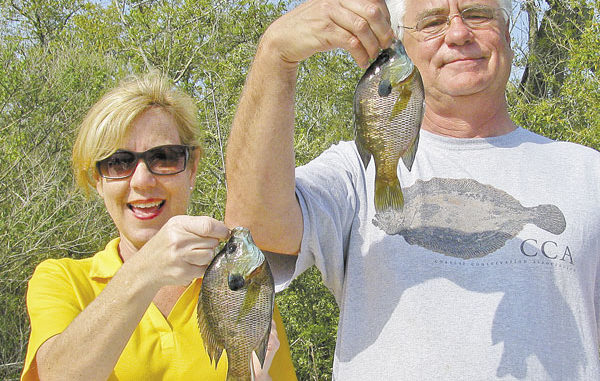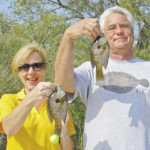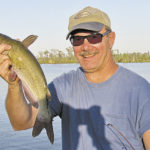
This popular lake in Southcentral Louisiana produces a seemingly endless supply of bream and catfish.
The gals gasped and giggled as Doc and Trisha’s Mediterranean cruise pictures flashed on the screen. And on his new mega-screen TV at his Bourbon Street bungalow, they were indeed impressive — especially the one of Trisha “wade-fishing” in Rome’s Trevi fountain.
And leave it to Doc to time Frank Sinatra’s “Three Coins in a Fountain” as the soundscore, just as Trisha splashed onto the screen in her … ?
“It’s a bikini bottom!” she clarified to the raucous and inquisitive crowd. “That’s all most women wear when swimming or sunning along the northern Mediterranean. Figures you yahoos would be oblivious to that!”
Doc and Trisha’s pics displayed gorgeous scenery, festive faces and uninhibited sunbathers from the Mediterranean ports of Malaga to Monte Carlo, from Marseilles to Messina and from Dubrovnik to Venice.
“Heck man,” Nick (Scramuzza) blurted while heading for the wet bar. “You mighta seen some of my relatives on the stop in Messina, without knowing, of course!
“Heck I wouldn’t have known them either!”
“Same for ours in Malaga!” said Johnny (Romero).
“Ditto for ours in Dubrovnik!” said Danny (Vujnovich).
“If you’d gone a bit east to Beirut, you mighta found mine!” added Paul (Monsour)
“And mine live supposedly in Marseilles,” said Doc (Fontaine) while hoisting his wine glass… “Whose wine? What wine? Where the heck did I dine?” he added, crooning the lyrics from one of our TigerTown theme songs, courtesy of Peter Frampton.
“Well,” and Doc tinkled his wine glass. “Our next cruise starts in Venice.”
Then, as his ethnic melting pot of guests turned toward him wide-eyed, he motioned Trisha off his lap with a friendly pat to her posterior and headed toward his wine rack. “So who’s coming this time?”
“We’re ALL going!” giggled Cindy while toasting Trisha. “Right after we win the lottery!”
“No problemo,” Doc nodded. “This cruise is on me. I’m picking up the tab.”
“RIGHT!” Pelayo said.
And we all joined in the hoots and catcalls.
“OK, OK,” Doc said while holding his arms out in a conciliatory gesture. “Actually somebody else is picking it up for me. Y’all might remember Gina’s divorce lawyer, Gabe? The shyster skunk who cleaned me out and hung me out to dry 10 years ago? Well, he’s making it up to me, somewhat.
“Don’t ask me the details, but he’s gotten British Petroleum to pay for this cruise, among a few other things.”
“HUH?!” All eyes and ears were now focused on Doc.
“This cruise will start in my houseboat in Venice…”
“THAT Venice!” shrieked Cindy while sticking out her tongue and pointing her index finger tonsil-ward in a gagging motion. “Okay we get it.”
“… and continue to Morgan City.” Doc said as he smiled all around. “All are invited.”
“So THAT’s the scam!” Eddie laughed. “I think I get it — you’re getting your houseboat away from the catastrophic oil spill and over to safer docking — and you’ve found a way to let BP off easy for all your ‘horrible suffering, right?”
“Well that’s PART of it,” Doc smirked. “My cousin Sean in Baton Rouge says the panfishing’s really hot in the Lake Verret area right now too.
“He also says that, in light of the spill, I’d better — heck we’d ALL better — get used to fresh water for a while!”
“Oh it’s all so tragic!” wailed Priscilla. “Our coast, our seafood, our culture, our very way of life has been destroyed — perhaps for our lifetime!” (Priscilla spends most of her days getting pedicures and massages at a spa, not exactly poking through a pickbox.)
“Those BP scumbags oughta be strung up by their … !” added her husband Spencer.
“And flayed alive!” contributed Priscilla’s friend Meghan. “‘How do you compensate for a destroyed way of life?’ as Billy Nungesser so eloquently expressed to the national news yesterday?!”
“And what’s Nungesser doing in Plaquemines Parish anyway?” asked Eddie. “I read that right before shooting a crying scene, Elizabeth Taylor would pluck a nostril hair to get the tears rolling. Heck, Nungesser cranks them out at will, whenever the cameras start rolling. Why ain’t he in Hollywood? He could call in Jindal as an extra! They’d be much more famous than they are now!”
“It’s an old story down here, Eddie,” Pelayo added. “Watch old clips of Huey Long bashing Standard Oil. He’d stomp, roll his eyes, squeeze tears, bash his fist into his palm — the whole bit. And the people and media ate it up. Nungesser has nothing on the Kingfish.”
“Or on Jimmy Swaggart!” added Artie. “Boy, did he make the tears gush on command!”
The discussion got much livelier, but regardless, the hysterical fishing closures and hysterical media coverage caused our traditional Breton Island Trout Blast to move slightly westward for a Lake Verret Panfish Blast —and just as the fishing turned on big-time in this renown panfish (bluegill, catfish especially) area. So what makes it such a hotspot, compared to others with (superficially) similar habitat?
“Here’s the deal, Hom-boy-da,” says the expert in this matter, the LDWF inland fisheries biologist Alex Perret. “The Lake Verret area, in which I include Grassy Lake and all the surrounding network of bayous and canals, contains absolutely all the essential ingredients for fabulous panfish production.
“First off, it’s an overflow swamp. Such habitat always produces the most panfish because it provides the most food and cover for panfish, especially food. That huge swamp is a breeding ground for an enormous buffet of insects, crustaceans, snails, frogs, salamanders, worms — you name it.
“The water comes up, overflows into that flooded swamp and the panfish have a feast. The water starts dropping, and this buffet channels into the main lake through the network of little bayous, sloughs and trenasses. You don’t find this phenomenon in completely land-locked ponds or lakes or creeks or rivers. They might produce plenty of panfish — but nothing like the panfish factory known as Lake Verret.”
“And let me add this,” said Alex Perret’s LWDF biologist colleague, Bryan Hermann. “These overflow swamps also provide a habitat that ensures great spawning success for panfish — much better than in most places.
“You see, during most of the year, that overflow swamp around Lake Verret is dry, and the ground hardens. Well, freshwater game fish like to spawn on a hard or sandy bottom. Their eggs need oxygen. If they’re laid in mush or mud, they often sink and smother to death. On hard bottom they’re exposed to the oxygen, so they thrive and hatch.
“So that’s what panfish look for. And that’s exactly what they find around the banks of Lake Verret during the spawning season. They find the perfect depth, 2-4 feet, along with a hard substrate. Here a good portion of the eggs will hatch.”
“And also,” continues Alex Perret, “once those eggs hatch, Lake Verret again offers the perfect habitat for the fry growing.
“The lake’s abundant submerged vegetation provides them a great place to hide from predators. Lake Verret, according to our studies, contains about 30 percent submerged vegetation, which is just about perfect, giving the fry a great place to hide and feed — but not smothering the entire lake and making it unfishable, as happens in other freshwater areas.
“Lake Verret also benefits from the fertile Atchafalaya Spillway waters, but without the huge tidal fluctuations and silting up that affect the Basin itself. The water enters Lake Verret more slowly and is better filtered, thus clearer. So again, Lake Verret gets the upside without much of the downside.
“That forest of cypress trees that surrounds Lake Verret and that grows well out into it provides the perfect habitat as the fish grow. On the surface you see a cypress knee, but under that is a network of knees and roots, all providing great cover. The catfish especially swarm into this type of cover.”
The offshore platforms came to mind when inland-fisheries wiz Perret mentioned this type of structure and cover. What you see above the surface is a tiny portion of the fabulous fish habitat that spreads out below.
Well, Doc’s “cruise” fell through, after discovering that he could keep his houseboat in Venice, rent it out to BP and others for a sum that even Gabe found “equitable.” So the Verret Blast was headquartered at Sean’s camp near Stephensville.
Five of us crowded into Eddie’s bay boat, and made for the canal network off the eastern shore of the lake, and after a little cruising around found a slough emptying its root beer-colored outflow into the murkier canal. Some cypress knees studded the area, and we were surrounded by a gorgeous cypress-tupelo swamp. The place had classic Lake Verret action written all over it.
We edged toward the bank, and the marsh anchor went out. Pelayo reached in the bucket for some of the prized grass shrimp we’d scooped up earlier. I was already rigged up with a blue/black mini-jig about 2 feet under a 2-inch Styrofoam cork. I tipped the tiny hook with a pinch of market shrimp and cast toward the “rip.” I watched Pelayo’s cork hit a cypress knee, twitch once and vanish.
“They’re here!” he whooped.
The look on Pelayo’s face as the ultralight pole arched and the 6-pound-test buzzed off the reel was identical to the one he had as he battled blackfin tuna a month earlier.
“Man, these perch put up a heck of a fight for their size,” he said.
He beamed while tossing the big bluegill into the box.
Then my cork plunged, and I yanked the hook home, watched my ultralight rod arch and looked around gloating, especially when my fish hit the surface twirling and splashing in classic channel cat fashion.
“Perfect filleting and frying size!” I whooped while unhooking.
Then two chunky “perch” hit my quickly-rebaited market bait in short order.
Then I turned as Eddie yelled out “Nice green-trout!” from the bow. I turned again to see Doc’s nephew Clayton swing one aboard.
Clayton had grown up in Atlanta and become a bass fisherman in the process. So he turned up his nose at our live and market bait and insisted on casting small spinnerbaits. Now he smirked at us in vindication.
“WHAT?!” Eddie yelled at Clayton right after the splash. “Why’d you throw back that green trout! Ya crazy?”
“Green trout?” The boy looked around mystified. “What do you mean? That was no kind of trout. It was largemouth bass, and a juvenile one at that. By releasing him we ensure…”
“Look Clay,” Eddie said. “We’re good hosts so we’ll indulge you a bit. But that green trout was legal, and he woulda fried up nicely at tonight’s feast!”
“Like this one!” Pelayo whooped as he swung another green trout aboard. “That’s what I love about grass shrimp.”
Pelayo smirked while chunking his green-trout in the “box” (more perplexity for Clayton, more accustomed to live wells). “EVERYTHING munches out on them. That makes bluegill, chinquapin, catfish, sac-a-lait and now a green trout, all caught on live grass shrimp.”
“Don’t forget the choupique,” Chris reminded him, just as his cork hit the big cypress trunk and plopped in the water. The cricket underneath it didn’t last long. Chris’ ultralight spinning outfit was soon swinging in another chunky “perch.”
After two dozen or so more fish (with classic chunky Lake Verret bluegill predominating), the bite petered out. We made our way to the lake itself, and started trolling around the cypress trees in about 3-foot depths. The results were practically identical (variety and numbers) as they’d been in the canal, but with a few more beautiful channel cats.
These were no doubt courtesy of that abundant underwater cover from the cypress root network Alex Perret had explained. The scenery was as gorgeous out here and highlighted by a bald eagle, which distracted me as my cork plunged. After a brief battle, I pulled out a gorgeous redear, the kind we regard as filletable and call lakerunners.
“Man, I love this kind of fishing,” I thought to myself as I chunked him in the box.
These red-eared sunfish (technically) seem to prefer small crustaceans (grass shrimp, tiny crawfish) over anything else. Not that they’ll pass up a worm or cricket, just that they readily inhale my little chunk of market shrimp, which is much easier to bait-up with.
Indeed there appeared no preference for one bait over the other, except the catfish obviously preferring my little chunks of market shrimp and little ditch crawfish (either live or crushed.) But without having to fumble around grabbing at a cricket or trying to impale a wiggly worm on the hook, I usually beat my fishing chums to the cast to the choice spot.
Looking around, I could only think of all those signs advertising a “Swamp Tour” — and thus what so many of us take for granted in South Louisiana. Most of our freshwater fishing trips qualify as “swamp tours,” if you think about it.
Every day tourists from around the world pay good money to sigh and gasp at the same scenery we snore at on the way to our honeyholes. An engineer from Frankfurt marvels at swamp maple blooming in vivid red. To us it might as well be a lightpole. A cottonmouth moccasin bracketed by blooming white iris gets half a roll of snapshots from a Japanese accountant. From us it gets three cylinders from the .357 magnum. An alligator immersed in duckweed has a whole boatload of Chicagoans shrieking and cooing in wonder. All we do is smack our lips; we’d rather see the gator immersed in a sauce picante. We study a twirling buzz bait rather than the towering, centuries-old cypress behind it. We focus on a piece of Styrofoam rather than the snowy egret in elegant spring plumage behind it. We’re riveted by the electronic blips on a fish-finder rather than the swamp owl peering down from the moss-draped branch of a tupelo gum. We follow the path of a painted water snake with the crosshairs on the .22 rimfire rather than a zoom lens.
At least we used to. Around Lake Verret, it’s easy to get distracted, but the constant action also keeps you attentive to your little bobbing cork. And oh, the pile of these fresh panfish fillets dipped in beer mustard batter then rolled in a mixture of corn flour, corn starch, garlic powder and cajun seasoning, and fried in peanut oil on the deck of Sean’s camp — it don’t get no better!

